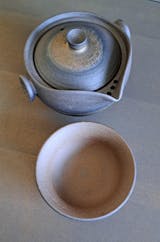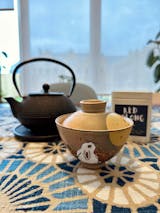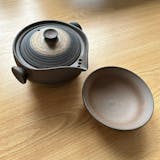At Gohobi, we take pride in collaborating with skilled artisans to ensure that our teaware embodies the finest quality and luxurious touch. If you’re searching for exquisite craftsmanship and beautifully crafted products, you’ve come to the right place. Plus, we offer personalised services tailored to bring your unique projects to life!
Customised Services
-
Bulk Customisation: Let’s align our offerings with your branding and specific needs.
-
Product Tailoring: We’d love to chat with you to discover the perfect fit for your project!
-
Hassle-Free Delivery: Count on us to deliver your orders promptly and reliably.
Got questions? Don’t hesitate to reach out via email at sales@gohobi.co.uk or through our live chat. We’re here to help!
We take pride in our dedication to craftsmanship. Here’s a peek at the exquisite materials and techniques used in our stunning pieces.
Blue and White Porcelain
Blue and white porcelain, known as Qinghua (青花), is one of the most iconic forms of Chinese ceramics. It originated in the Yuan Dynasty (1279–1368) and reached its peak during the Ming (1368–1644) and Qing (1644–1912) Dynasties. Characterised by intricate cobalt blue designs on a white porcelain base, this art form features cobalt blue pigment applied under a clear glaze, creating a striking contrast.
The creation of Qinghua porcelain is a complex process that requires both artistic talent and technical skill. From choosing raw materials to the final firing, each step presents challenges that can affect the quality of the finished piece. This craftsmanship is what makes Qinghua so revered, with each item showcasing the mastery of the artisans. Today, its timeless beauty continues to captivate collectors and admirers around the world.
Overglaze decoration
Overglaze decoration, or You Shang Cai (釉上彩) in Chinese, is a traditional ceramic technique where colourful designs are applied to the surface of already fired and glazed ceramics. After adding the decoration, the piece is fired again at a lower temperature (around 700-900°C) to set the colours without melting the glaze. This method allows for vibrant colours and intricate patterns, making it particularly popular in fine Chinese porcelain.
In contrast to underglaze techniques, which involve decorating before glazing and high-temperature firing, overglaze decoration is prized for its detailed and vivid designs. However, it requires a high level of skill due to challenges like maintaining colour consistency and managing the second firing. Despite these complexities, overglaze decoration remains a cherished part of ceramic artistry, resulting in some of the most ornate and beautiful porcelain pieces in Chinese culture.



Yixing Zisha Clay
Yixing Zisha clay teapots are famous worldwide for their unique qualities and craftsmanship. Originating from Yixing city in Jiangsu Province, China, these teapots have a history that dates back to the Song Dynasty (960–1279 AD). Made from zisha (purple clay), these unglazed teapots are known for their ability to enhance the flavour of tea due to their porous nature, which allows the clay to absorb the essence of the tea over time.
The Yixing region offers special types of clay, including zisha, hongni (red clay), and duanni (yellow clay), each contributing to the teapot's distinctive characteristics. The porous quality helps the teapot “breathe,” improving the taste of tea with continued use.
Crafting Yixing pottery is a specialised art that requires both skill and expertise. Despite the challenges of sourcing rare clay and controlling the firing process, these teapots are celebrated for their beauty and functionality, making them highly sought-after collector's items and a symbol of Chinese ceramic artistry.



Wood-Fired Kiln (Chai Yao)
Wood-fired kiln, known as Chai Yao (柴烧), is one of the oldest traditional methods for firing ceramics. This ancient technique uses wood as the sole fuel source, reaching extremely high temperatures. The process is unpredictable, leading to unique effects on the ceramics' surfaces, as ashes from the burning wood interact with the glaze, creating natural patterns and textures.
Chai Yao is highly prized for the rustic, organic aesthetics it imparts, making each piece distinct and unrepeatable. Despite its challenges, the individuality of wood-fired ceramics reflects the skill and dedication of the artisans, celebrating the harmonious balance of nature, fire, and craftsmanship.


Kohiki
Kohiki (粉引) is a distinctive style of Japanese pottery that originated from Korea in the 16th century. Known for its rustic charm, Kohiki features a soft, milky white surface achieved through a unique glazing technique. The process begins with a coarse clay body, which is coated with a white slip—a mixture of clay and water—before being covered with a translucent glaze and fired. This gives the pottery its characteristic whitewashed look, showcasing variations in texture and colour that highlight the handmade nature of the craft.
Often used in tea ceremonies and as everyday tableware, Kohiki embodies the wabi-sabi aesthetic, which celebrates imperfection and the beauty of natural ageing. Key features include:
-
White Slip: A light coating that enhances the clay’s texture while providing a milky tone.
-
Translucent Glaze: Creates a smooth, slightly glossy finish over the slip.
-
Rustic Aesthetic: Displays rough textures and natural colour variations, reflecting the artisanal process.
Despite challenges like fragility and the unpredictability of firing, Kohiki pottery is cherished for its understated elegance and traditional craftsmanship, balancing imperfections with artistry.



Shino Ware
Shino Ware (志野烧, Shino-yaki) is a traditional Japanese ceramic style that emerged in the late 16th century during the Momoyama period. Renowned for its thick, milky white or soft grey glazes with reddish-orange or peach undertones, Shino pottery features unique characteristics like subtle crackles, pinholes, and colour variations that give it a rustic, organic feel.
Often associated with tea bowls used in the Japanese tea ceremony, Shino Ware is also crafted into plates, vases, and other functional items. Its natural imperfections are celebrated as part of its beauty, though creating Shino pottery can be challenging due to the unpredictability of glaze and firing conditions. This blend of traditional techniques and spontaneity makes Shino-yaki a cherished form of Japanese ceramics.



Traditional Liuli
Traditional Liuli (琉璃), also known as Chinese glazed glass, is an ancient glassmaking art that originated during the Han Dynasty (206 BC–220 AD). This craft involves melting glass at high temperatures to create decorative items, jewellery, and religious artefacts in vibrant, translucent colours like deep blues, greens, yellows, and reds. Traditionally, Liuli was used to make intricate sculptures, figurines, and vessels, often symbolizing wealth and spirituality in Chinese culture.
One common technique in Liuli production is Pâte de Verre, where finely ground glass is placed in molds and melted in a kiln. This method allows for detailed designs and stunning multi-coloured pieces with unique textures and luminosity.
Today, Liuli craftsmanship blends modern techniques with ancient practices, resulting in contemporary art pieces that honour this historical art form. Despite its challenges—like material fragility and complex color control—Liuli remains a celebrated craft, admired for its beauty and cultural significance. Each piece reflects the skill and dedication of its artisan, making Liuli a lasting symbol of Chinese heritage.



Contact us
Need some guidance choosing your products? Reach out to us via email sales@gohobi.co.uk or live chat. We're here to assist you.


























